Assignment on Tourism Industry in Northeast India
VerifiedAdded on 2021/01/16
|11
|2182
|139
AI Summary
Contribute Materials
Your contribution can guide someone’s learning journey. Share your
documents today.
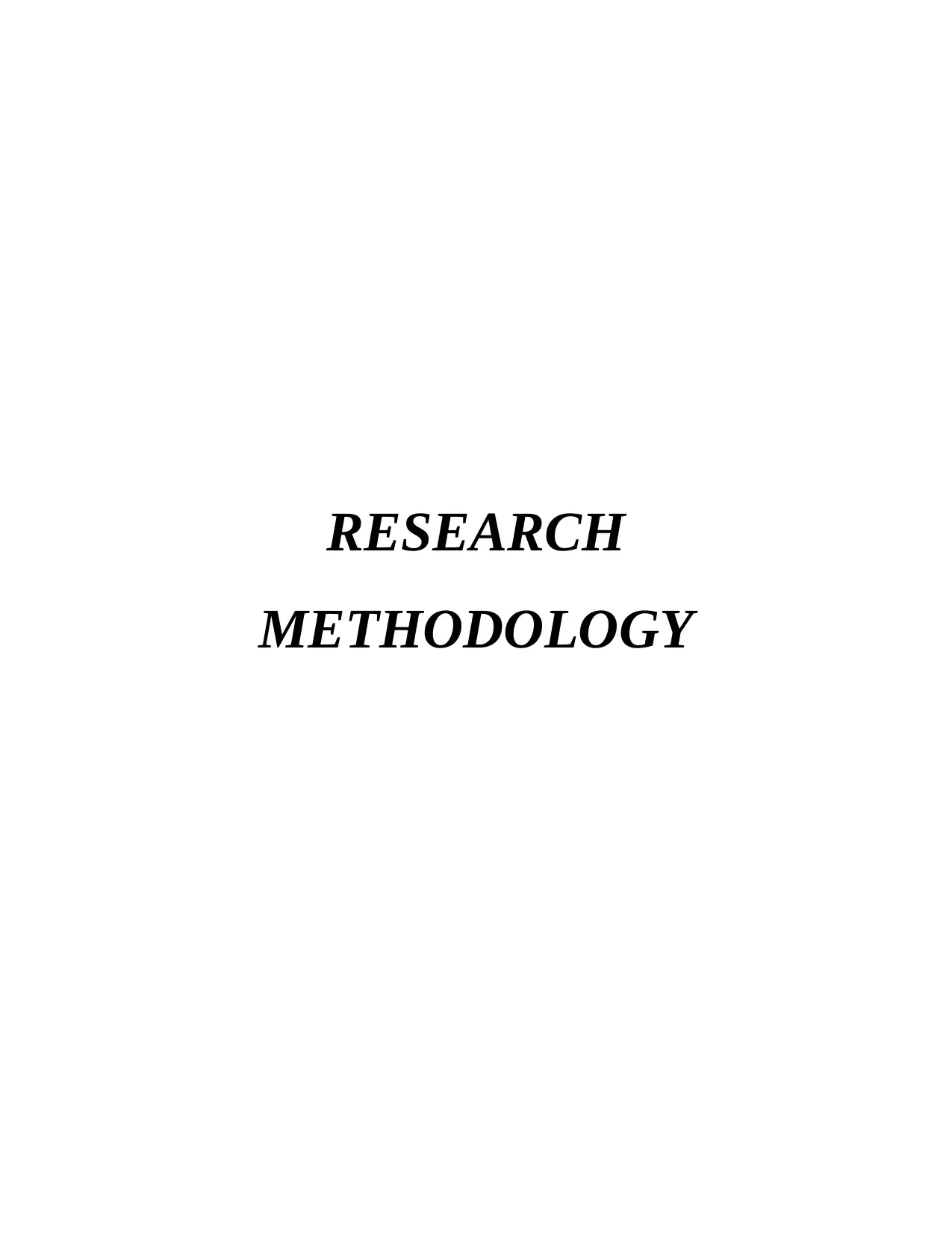
RESEARCH
METHODOLOGY
METHODOLOGY
Secure Best Marks with AI Grader
Need help grading? Try our AI Grader for instant feedback on your assignments.
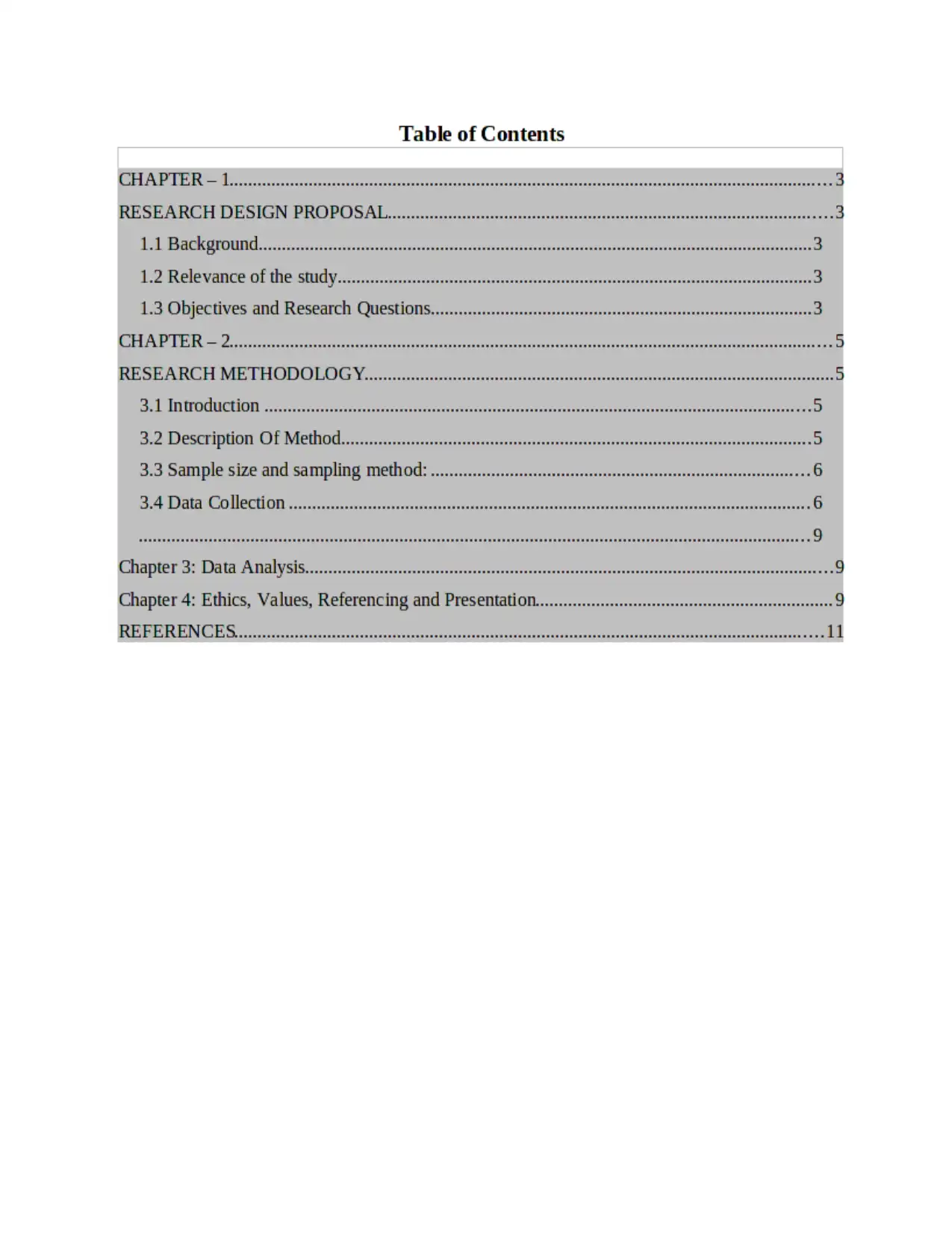
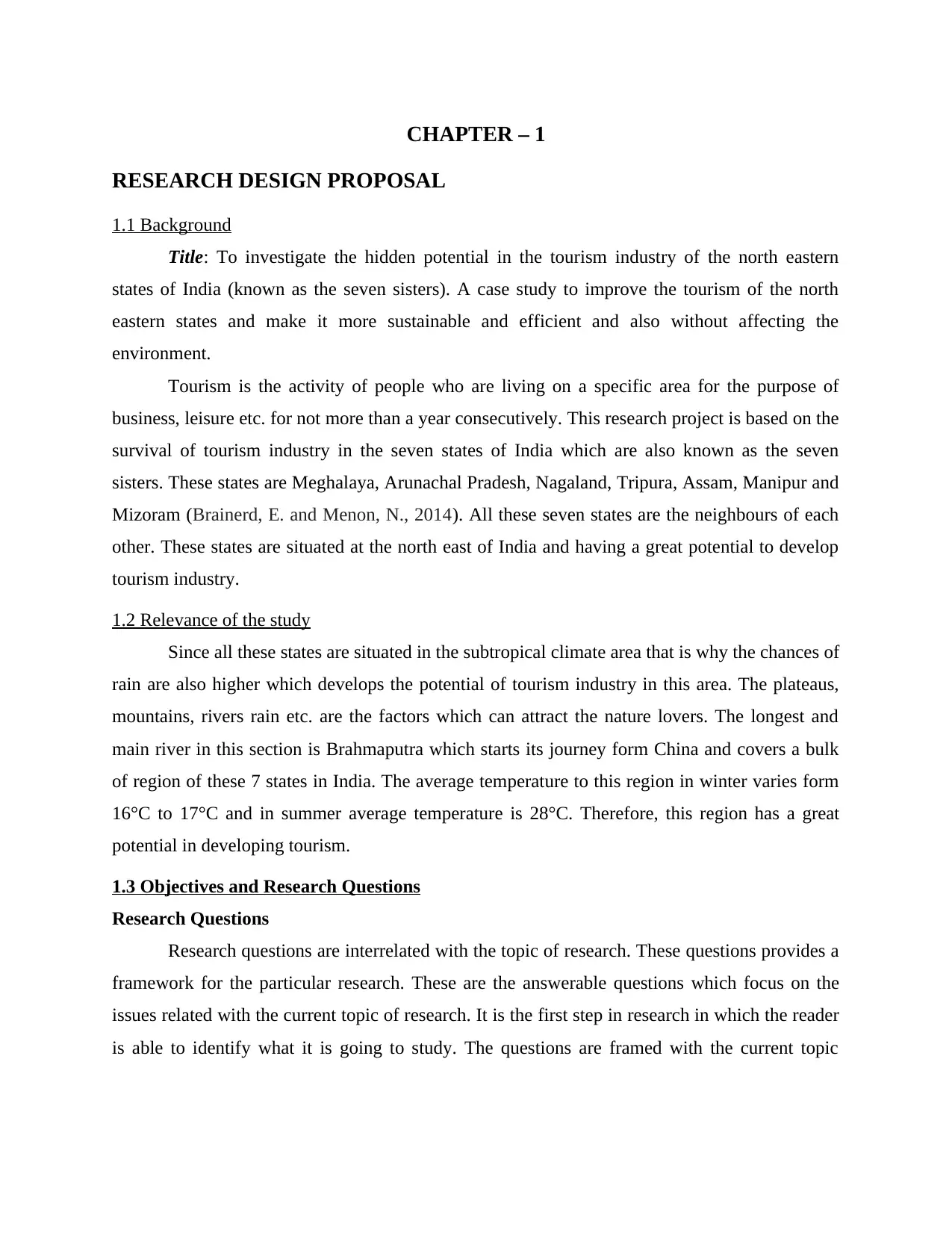
CHAPTER – 1
RESEARCH DESIGN PROPOSAL
1.1 Background
Title: To investigate the hidden potential in the tourism industry of the north eastern
states of India (known as the seven sisters). A case study to improve the tourism of the north
eastern states and make it more sustainable and efficient and also without affecting the
environment.
Tourism is the activity of people who are living on a specific area for the purpose of
business, leisure etc. for not more than a year consecutively. This research project is based on the
survival of tourism industry in the seven states of India which are also known as the seven
sisters. These states are Meghalaya, Arunachal Pradesh, Nagaland, Tripura, Assam, Manipur and
Mizoram (Brainerd, E. and Menon, N., 2014). All these seven states are the neighbours of each
other. These states are situated at the north east of India and having a great potential to develop
tourism industry.
1.2 Relevance of the study
Since all these states are situated in the subtropical climate area that is why the chances of
rain are also higher which develops the potential of tourism industry in this area. The plateaus,
mountains, rivers rain etc. are the factors which can attract the nature lovers. The longest and
main river in this section is Brahmaputra which starts its journey form China and covers a bulk
of region of these 7 states in India. The average temperature to this region in winter varies form
16°C to 17°C and in summer average temperature is 28°C. Therefore, this region has a great
potential in developing tourism.
1.3 Objectives and Research Questions
Research Questions
Research questions are interrelated with the topic of research. These questions provides a
framework for the particular research. These are the answerable questions which focus on the
issues related with the current topic of research. It is the first step in research in which the reader
is able to identify what it is going to study. The questions are framed with the current topic
RESEARCH DESIGN PROPOSAL
1.1 Background
Title: To investigate the hidden potential in the tourism industry of the north eastern
states of India (known as the seven sisters). A case study to improve the tourism of the north
eastern states and make it more sustainable and efficient and also without affecting the
environment.
Tourism is the activity of people who are living on a specific area for the purpose of
business, leisure etc. for not more than a year consecutively. This research project is based on the
survival of tourism industry in the seven states of India which are also known as the seven
sisters. These states are Meghalaya, Arunachal Pradesh, Nagaland, Tripura, Assam, Manipur and
Mizoram (Brainerd, E. and Menon, N., 2014). All these seven states are the neighbours of each
other. These states are situated at the north east of India and having a great potential to develop
tourism industry.
1.2 Relevance of the study
Since all these states are situated in the subtropical climate area that is why the chances of
rain are also higher which develops the potential of tourism industry in this area. The plateaus,
mountains, rivers rain etc. are the factors which can attract the nature lovers. The longest and
main river in this section is Brahmaputra which starts its journey form China and covers a bulk
of region of these 7 states in India. The average temperature to this region in winter varies form
16°C to 17°C and in summer average temperature is 28°C. Therefore, this region has a great
potential in developing tourism.
1.3 Objectives and Research Questions
Research Questions
Research questions are interrelated with the topic of research. These questions provides a
framework for the particular research. These are the answerable questions which focus on the
issues related with the current topic of research. It is the first step in research in which the reader
is able to identify what it is going to study. The questions are framed with the current topic
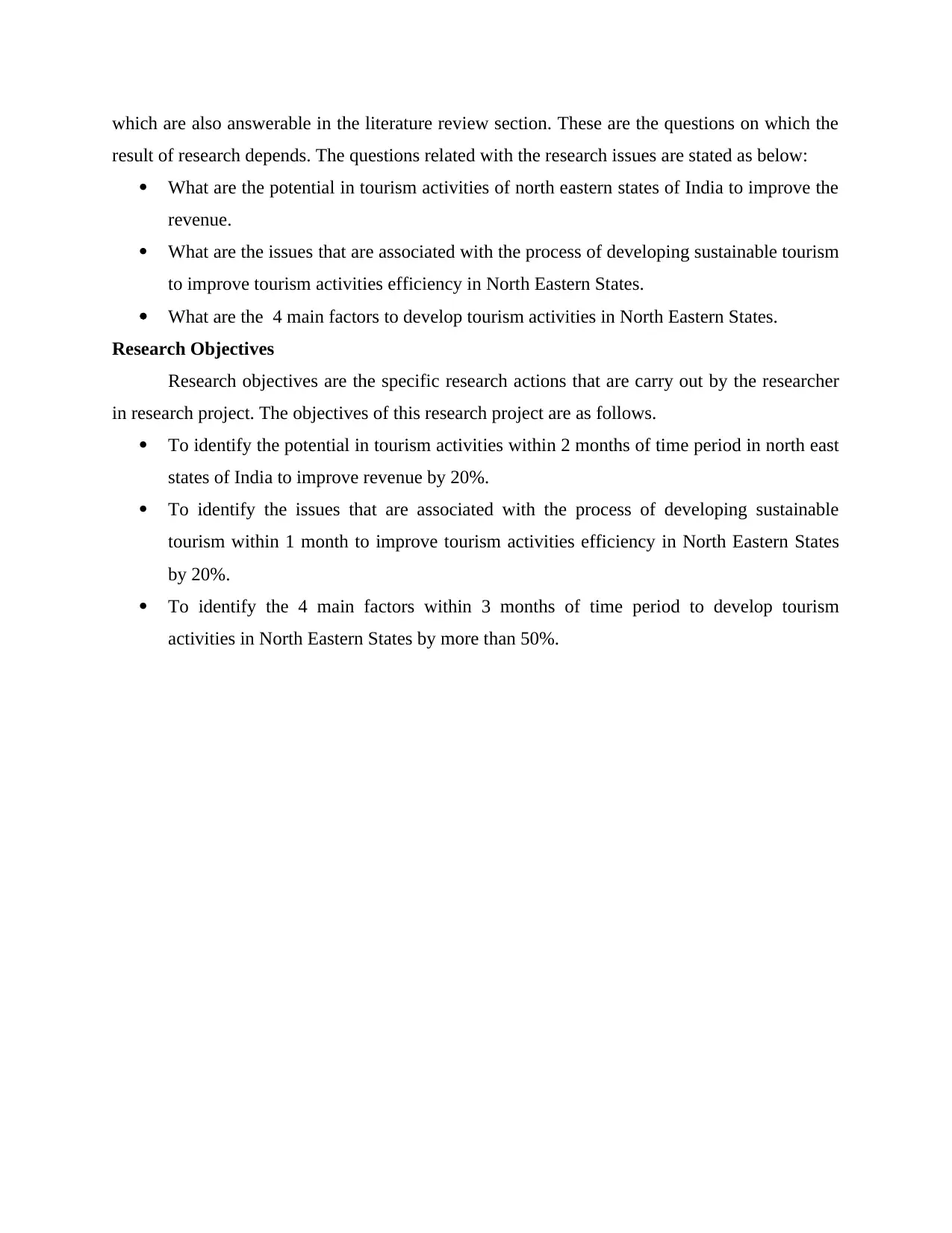
which are also answerable in the literature review section. These are the questions on which the
result of research depends. The questions related with the research issues are stated as below:
What are the potential in tourism activities of north eastern states of India to improve the
revenue.
What are the issues that are associated with the process of developing sustainable tourism
to improve tourism activities efficiency in North Eastern States.
What are the 4 main factors to develop tourism activities in North Eastern States.
Research Objectives
Research objectives are the specific research actions that are carry out by the researcher
in research project. The objectives of this research project are as follows.
To identify the potential in tourism activities within 2 months of time period in north east
states of India to improve revenue by 20%.
To identify the issues that are associated with the process of developing sustainable
tourism within 1 month to improve tourism activities efficiency in North Eastern States
by 20%.
To identify the 4 main factors within 3 months of time period to develop tourism
activities in North Eastern States by more than 50%.
result of research depends. The questions related with the research issues are stated as below:
What are the potential in tourism activities of north eastern states of India to improve the
revenue.
What are the issues that are associated with the process of developing sustainable tourism
to improve tourism activities efficiency in North Eastern States.
What are the 4 main factors to develop tourism activities in North Eastern States.
Research Objectives
Research objectives are the specific research actions that are carry out by the researcher
in research project. The objectives of this research project are as follows.
To identify the potential in tourism activities within 2 months of time period in north east
states of India to improve revenue by 20%.
To identify the issues that are associated with the process of developing sustainable
tourism within 1 month to improve tourism activities efficiency in North Eastern States
by 20%.
To identify the 4 main factors within 3 months of time period to develop tourism
activities in North Eastern States by more than 50%.
Secure Best Marks with AI Grader
Need help grading? Try our AI Grader for instant feedback on your assignments.
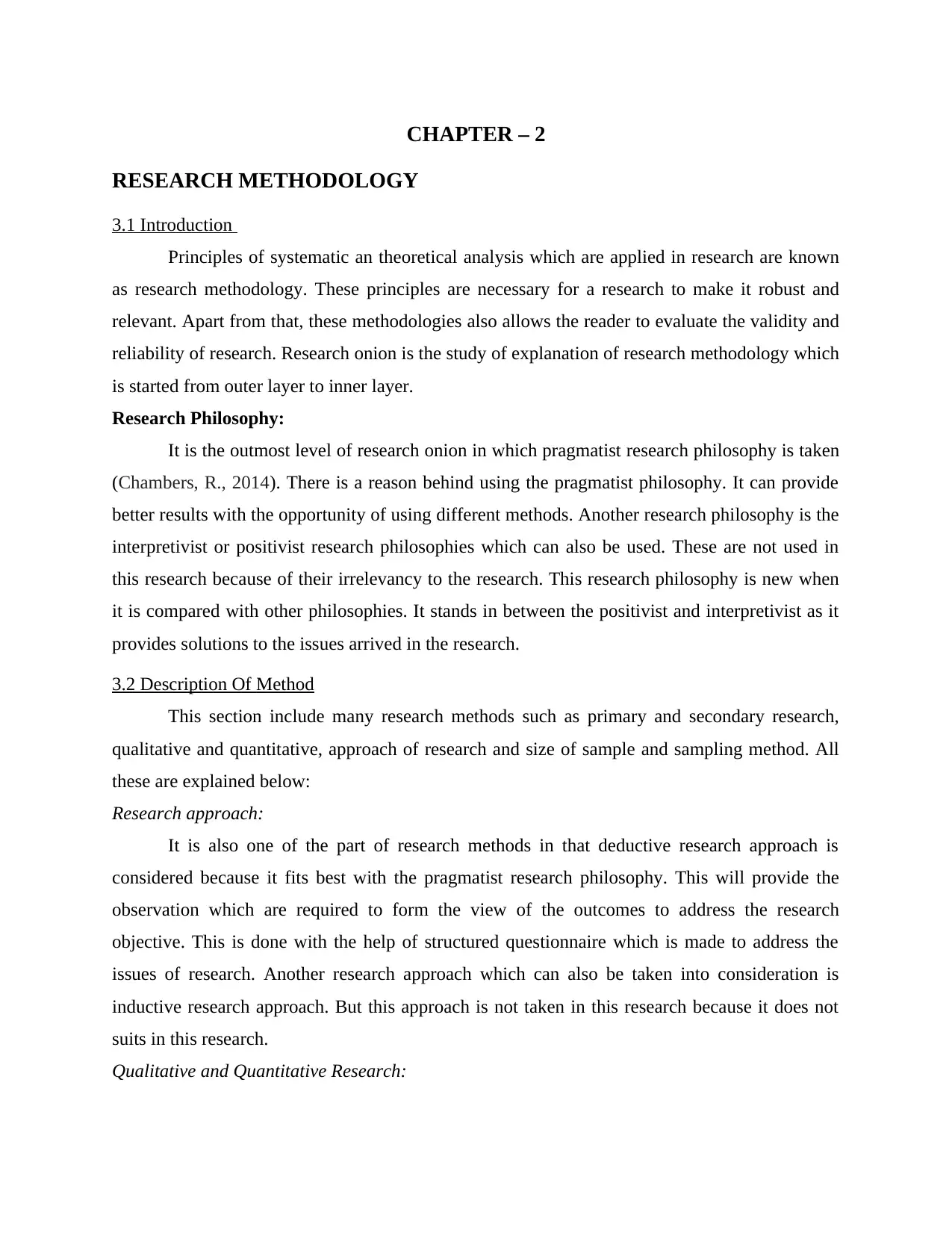
CHAPTER – 2
RESEARCH METHODOLOGY
3.1 Introduction
Principles of systematic an theoretical analysis which are applied in research are known
as research methodology. These principles are necessary for a research to make it robust and
relevant. Apart from that, these methodologies also allows the reader to evaluate the validity and
reliability of research. Research onion is the study of explanation of research methodology which
is started from outer layer to inner layer.
Research Philosophy:
It is the outmost level of research onion in which pragmatist research philosophy is taken
(Chambers, R., 2014). There is a reason behind using the pragmatist philosophy. It can provide
better results with the opportunity of using different methods. Another research philosophy is the
interpretivist or positivist research philosophies which can also be used. These are not used in
this research because of their irrelevancy to the research. This research philosophy is new when
it is compared with other philosophies. It stands in between the positivist and interpretivist as it
provides solutions to the issues arrived in the research.
3.2 Description Of Method
This section include many research methods such as primary and secondary research,
qualitative and quantitative, approach of research and size of sample and sampling method. All
these are explained below:
Research approach:
It is also one of the part of research methods in that deductive research approach is
considered because it fits best with the pragmatist research philosophy. This will provide the
observation which are required to form the view of the outcomes to address the research
objective. This is done with the help of structured questionnaire which is made to address the
issues of research. Another research approach which can also be taken into consideration is
inductive research approach. But this approach is not taken in this research because it does not
suits in this research.
Qualitative and Quantitative Research:
RESEARCH METHODOLOGY
3.1 Introduction
Principles of systematic an theoretical analysis which are applied in research are known
as research methodology. These principles are necessary for a research to make it robust and
relevant. Apart from that, these methodologies also allows the reader to evaluate the validity and
reliability of research. Research onion is the study of explanation of research methodology which
is started from outer layer to inner layer.
Research Philosophy:
It is the outmost level of research onion in which pragmatist research philosophy is taken
(Chambers, R., 2014). There is a reason behind using the pragmatist philosophy. It can provide
better results with the opportunity of using different methods. Another research philosophy is the
interpretivist or positivist research philosophies which can also be used. These are not used in
this research because of their irrelevancy to the research. This research philosophy is new when
it is compared with other philosophies. It stands in between the positivist and interpretivist as it
provides solutions to the issues arrived in the research.
3.2 Description Of Method
This section include many research methods such as primary and secondary research,
qualitative and quantitative, approach of research and size of sample and sampling method. All
these are explained below:
Research approach:
It is also one of the part of research methods in that deductive research approach is
considered because it fits best with the pragmatist research philosophy. This will provide the
observation which are required to form the view of the outcomes to address the research
objective. This is done with the help of structured questionnaire which is made to address the
issues of research. Another research approach which can also be taken into consideration is
inductive research approach. But this approach is not taken in this research because it does not
suits in this research.
Qualitative and Quantitative Research:
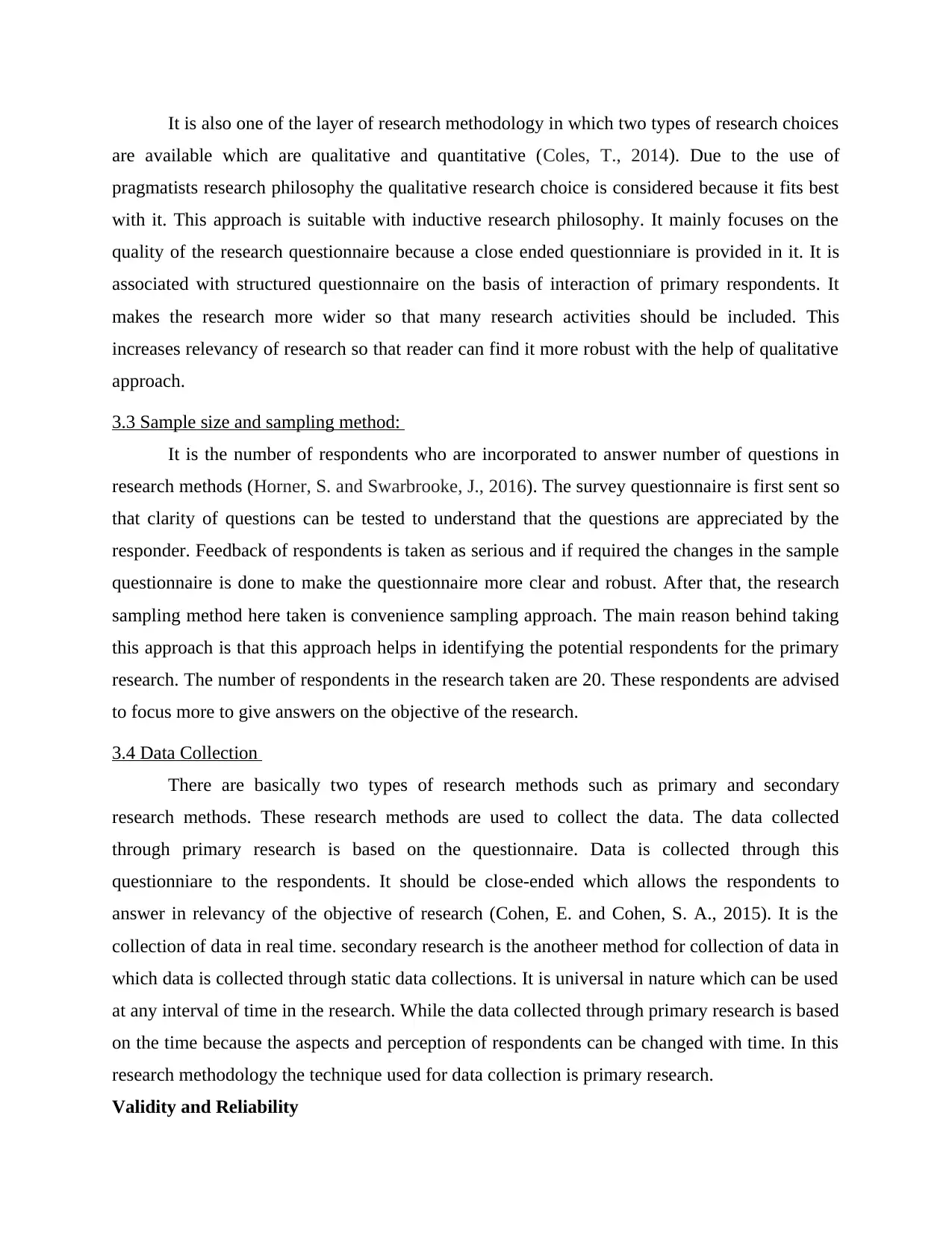
It is also one of the layer of research methodology in which two types of research choices
are available which are qualitative and quantitative (Coles, T., 2014). Due to the use of
pragmatists research philosophy the qualitative research choice is considered because it fits best
with it. This approach is suitable with inductive research philosophy. It mainly focuses on the
quality of the research questionnaire because a close ended questionniare is provided in it. It is
associated with structured questionnaire on the basis of interaction of primary respondents. It
makes the research more wider so that many research activities should be included. This
increases relevancy of research so that reader can find it more robust with the help of qualitative
approach.
3.3 Sample size and sampling method:
It is the number of respondents who are incorporated to answer number of questions in
research methods (Horner, S. and Swarbrooke, J., 2016). The survey questionnaire is first sent so
that clarity of questions can be tested to understand that the questions are appreciated by the
responder. Feedback of respondents is taken as serious and if required the changes in the sample
questionnaire is done to make the questionnaire more clear and robust. After that, the research
sampling method here taken is convenience sampling approach. The main reason behind taking
this approach is that this approach helps in identifying the potential respondents for the primary
research. The number of respondents in the research taken are 20. These respondents are advised
to focus more to give answers on the objective of the research.
3.4 Data Collection
There are basically two types of research methods such as primary and secondary
research methods. These research methods are used to collect the data. The data collected
through primary research is based on the questionnaire. Data is collected through this
questionniare to the respondents. It should be close-ended which allows the respondents to
answer in relevancy of the objective of research (Cohen, E. and Cohen, S. A., 2015). It is the
collection of data in real time. secondary research is the anotheer method for collection of data in
which data is collected through static data collections. It is universal in nature which can be used
at any interval of time in the research. While the data collected through primary research is based
on the time because the aspects and perception of respondents can be changed with time. In this
research methodology the technique used for data collection is primary research.
Validity and Reliability
are available which are qualitative and quantitative (Coles, T., 2014). Due to the use of
pragmatists research philosophy the qualitative research choice is considered because it fits best
with it. This approach is suitable with inductive research philosophy. It mainly focuses on the
quality of the research questionnaire because a close ended questionniare is provided in it. It is
associated with structured questionnaire on the basis of interaction of primary respondents. It
makes the research more wider so that many research activities should be included. This
increases relevancy of research so that reader can find it more robust with the help of qualitative
approach.
3.3 Sample size and sampling method:
It is the number of respondents who are incorporated to answer number of questions in
research methods (Horner, S. and Swarbrooke, J., 2016). The survey questionnaire is first sent so
that clarity of questions can be tested to understand that the questions are appreciated by the
responder. Feedback of respondents is taken as serious and if required the changes in the sample
questionnaire is done to make the questionnaire more clear and robust. After that, the research
sampling method here taken is convenience sampling approach. The main reason behind taking
this approach is that this approach helps in identifying the potential respondents for the primary
research. The number of respondents in the research taken are 20. These respondents are advised
to focus more to give answers on the objective of the research.
3.4 Data Collection
There are basically two types of research methods such as primary and secondary
research methods. These research methods are used to collect the data. The data collected
through primary research is based on the questionnaire. Data is collected through this
questionniare to the respondents. It should be close-ended which allows the respondents to
answer in relevancy of the objective of research (Cohen, E. and Cohen, S. A., 2015). It is the
collection of data in real time. secondary research is the anotheer method for collection of data in
which data is collected through static data collections. It is universal in nature which can be used
at any interval of time in the research. While the data collected through primary research is based
on the time because the aspects and perception of respondents can be changed with time. In this
research methodology the technique used for data collection is primary research.
Validity and Reliability
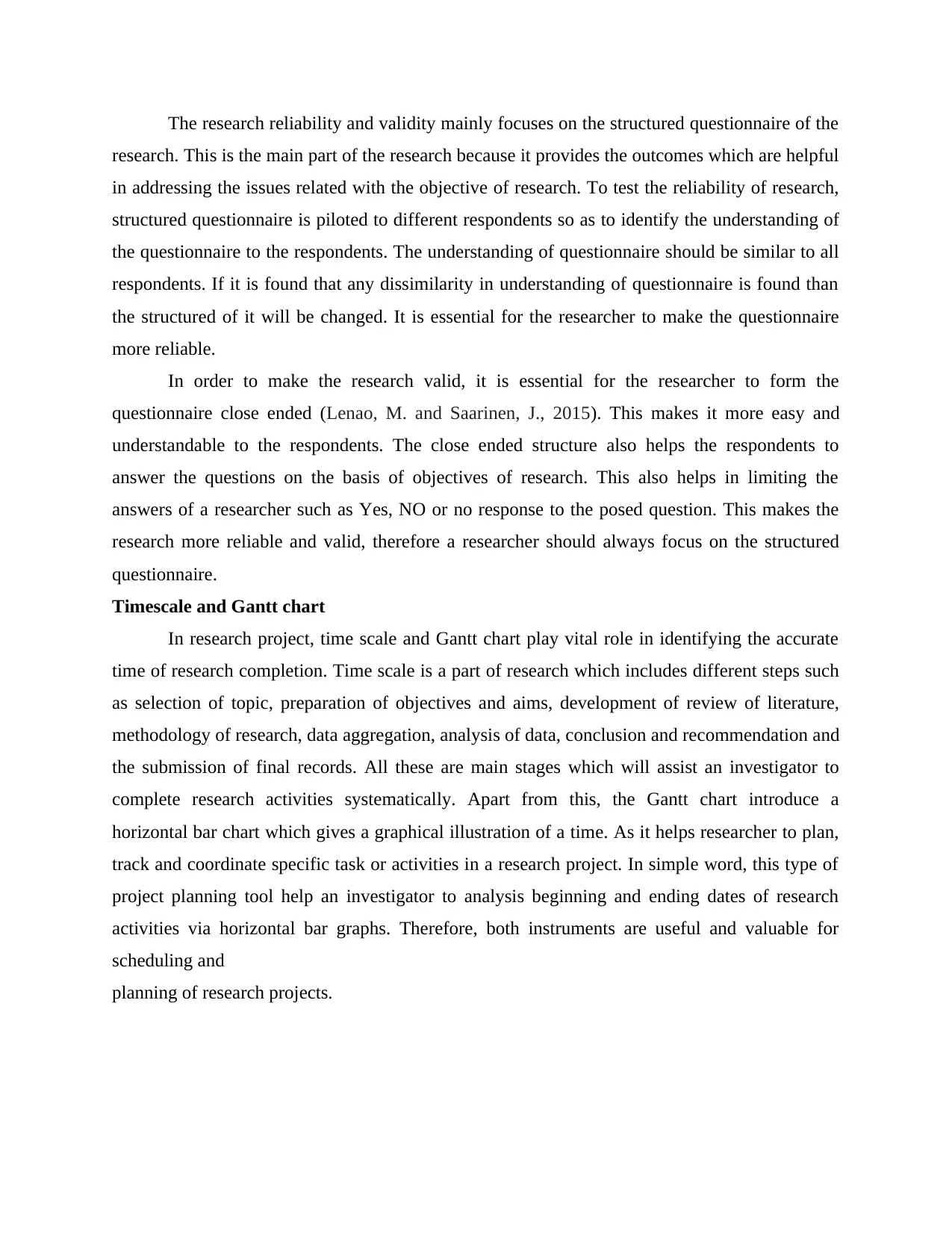
The research reliability and validity mainly focuses on the structured questionnaire of the
research. This is the main part of the research because it provides the outcomes which are helpful
in addressing the issues related with the objective of research. To test the reliability of research,
structured questionnaire is piloted to different respondents so as to identify the understanding of
the questionnaire to the respondents. The understanding of questionnaire should be similar to all
respondents. If it is found that any dissimilarity in understanding of questionnaire is found than
the structured of it will be changed. It is essential for the researcher to make the questionnaire
more reliable.
In order to make the research valid, it is essential for the researcher to form the
questionnaire close ended (Lenao, M. and Saarinen, J., 2015). This makes it more easy and
understandable to the respondents. The close ended structure also helps the respondents to
answer the questions on the basis of objectives of research. This also helps in limiting the
answers of a researcher such as Yes, NO or no response to the posed question. This makes the
research more reliable and valid, therefore a researcher should always focus on the structured
questionnaire.
Timescale and Gantt chart
In research project, time scale and Gantt chart play vital role in identifying the accurate
time of research completion. Time scale is a part of research which includes different steps such
as selection of topic, preparation of objectives and aims, development of review of literature,
methodology of research, data aggregation, analysis of data, conclusion and recommendation and
the submission of final records. All these are main stages which will assist an investigator to
complete research activities systematically. Apart from this, the Gantt chart introduce a
horizontal bar chart which gives a graphical illustration of a time. As it helps researcher to plan,
track and coordinate specific task or activities in a research project. In simple word, this type of
project planning tool help an investigator to analysis beginning and ending dates of research
activities via horizontal bar graphs. Therefore, both instruments are useful and valuable for
scheduling and
planning of research projects.
research. This is the main part of the research because it provides the outcomes which are helpful
in addressing the issues related with the objective of research. To test the reliability of research,
structured questionnaire is piloted to different respondents so as to identify the understanding of
the questionnaire to the respondents. The understanding of questionnaire should be similar to all
respondents. If it is found that any dissimilarity in understanding of questionnaire is found than
the structured of it will be changed. It is essential for the researcher to make the questionnaire
more reliable.
In order to make the research valid, it is essential for the researcher to form the
questionnaire close ended (Lenao, M. and Saarinen, J., 2015). This makes it more easy and
understandable to the respondents. The close ended structure also helps the respondents to
answer the questions on the basis of objectives of research. This also helps in limiting the
answers of a researcher such as Yes, NO or no response to the posed question. This makes the
research more reliable and valid, therefore a researcher should always focus on the structured
questionnaire.
Timescale and Gantt chart
In research project, time scale and Gantt chart play vital role in identifying the accurate
time of research completion. Time scale is a part of research which includes different steps such
as selection of topic, preparation of objectives and aims, development of review of literature,
methodology of research, data aggregation, analysis of data, conclusion and recommendation and
the submission of final records. All these are main stages which will assist an investigator to
complete research activities systematically. Apart from this, the Gantt chart introduce a
horizontal bar chart which gives a graphical illustration of a time. As it helps researcher to plan,
track and coordinate specific task or activities in a research project. In simple word, this type of
project planning tool help an investigator to analysis beginning and ending dates of research
activities via horizontal bar graphs. Therefore, both instruments are useful and valuable for
scheduling and
planning of research projects.
Paraphrase This Document
Need a fresh take? Get an instant paraphrase of this document with our AI Paraphraser
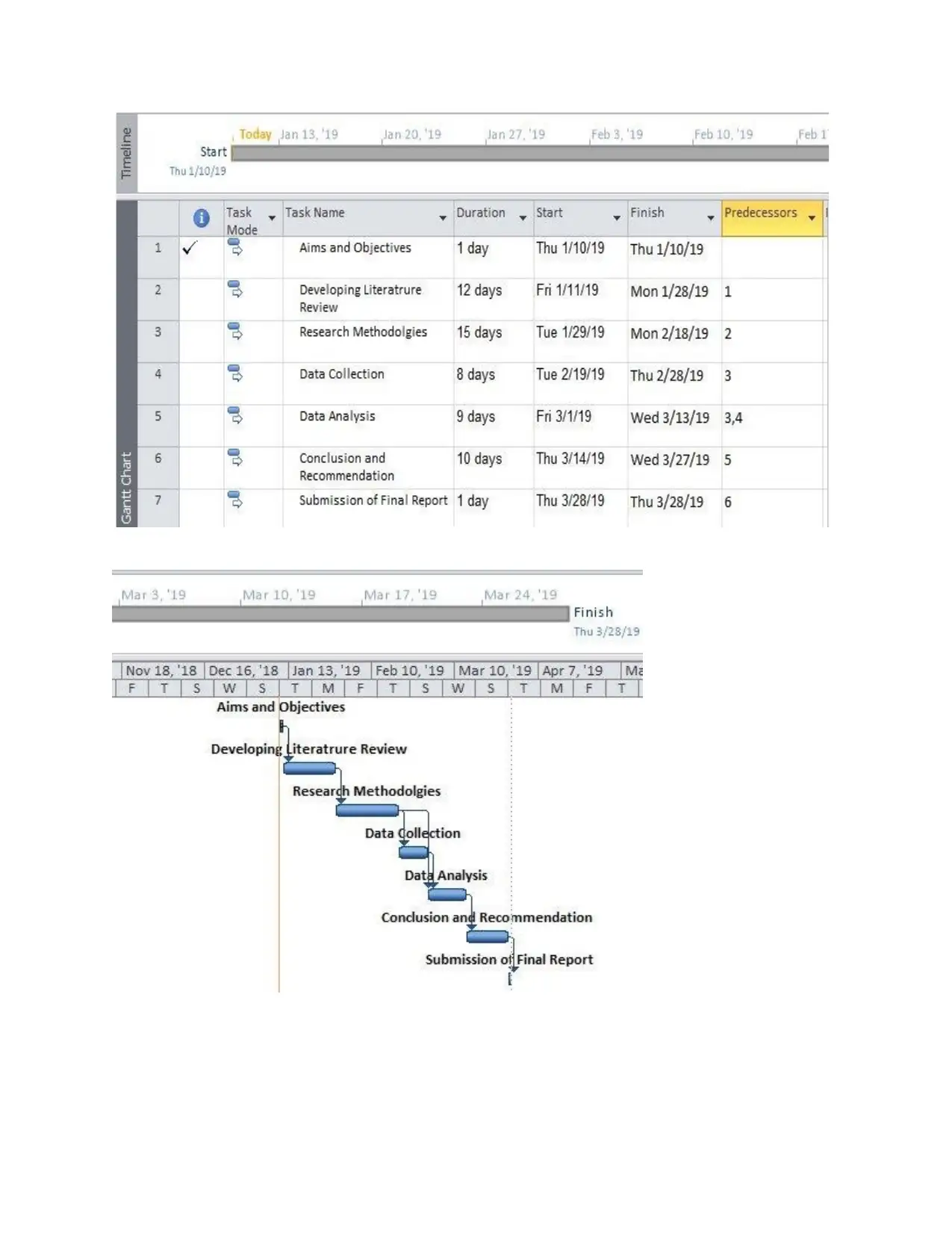
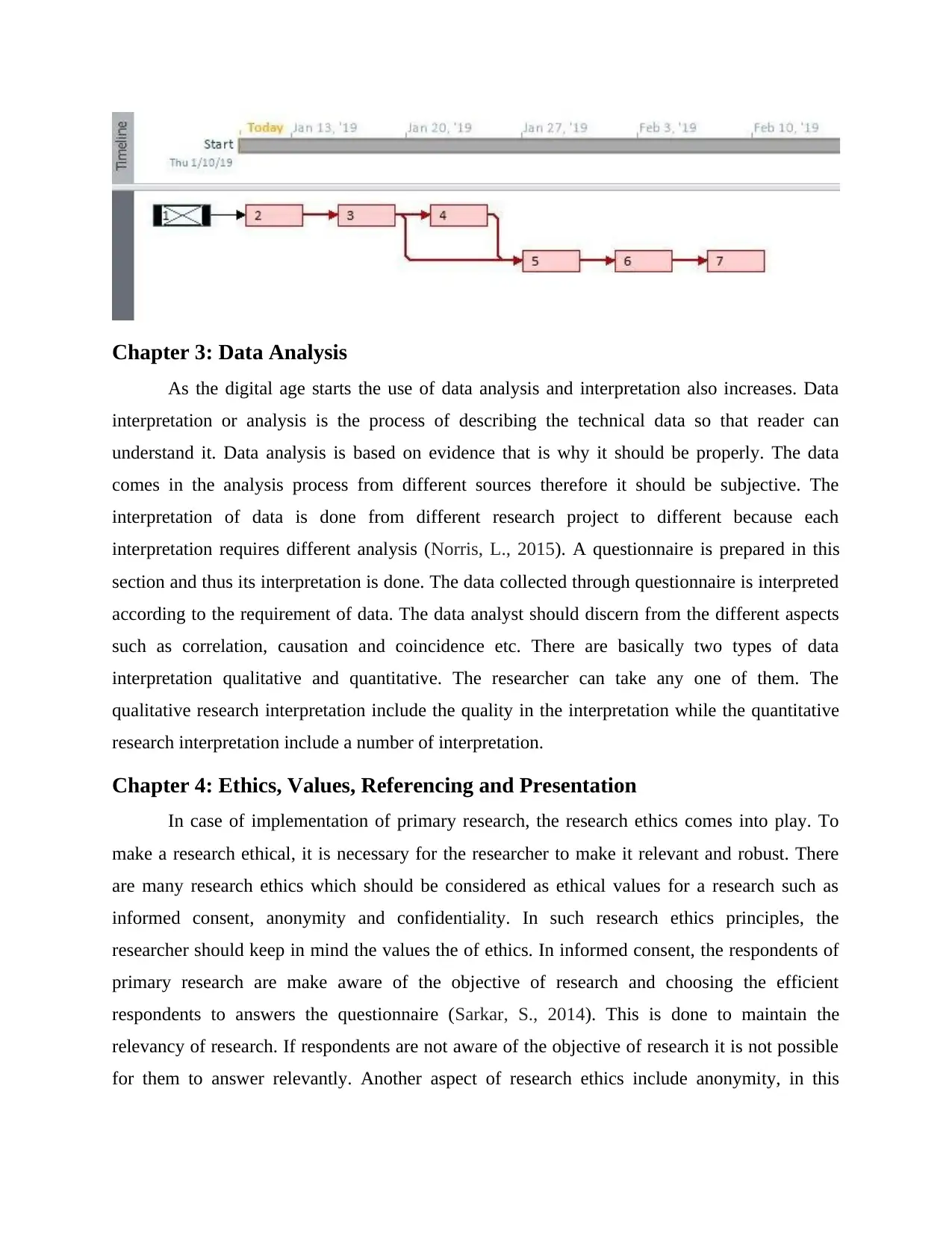
Chapter 3: Data Analysis
As the digital age starts the use of data analysis and interpretation also increases. Data
interpretation or analysis is the process of describing the technical data so that reader can
understand it. Data analysis is based on evidence that is why it should be properly. The data
comes in the analysis process from different sources therefore it should be subjective. The
interpretation of data is done from different research project to different because each
interpretation requires different analysis (Norris, L., 2015). A questionnaire is prepared in this
section and thus its interpretation is done. The data collected through questionnaire is interpreted
according to the requirement of data. The data analyst should discern from the different aspects
such as correlation, causation and coincidence etc. There are basically two types of data
interpretation qualitative and quantitative. The researcher can take any one of them. The
qualitative research interpretation include the quality in the interpretation while the quantitative
research interpretation include a number of interpretation.
Chapter 4: Ethics, Values, Referencing and Presentation
In case of implementation of primary research, the research ethics comes into play. To
make a research ethical, it is necessary for the researcher to make it relevant and robust. There
are many research ethics which should be considered as ethical values for a research such as
informed consent, anonymity and confidentiality. In such research ethics principles, the
researcher should keep in mind the values the of ethics. In informed consent, the respondents of
primary research are make aware of the objective of research and choosing the efficient
respondents to answers the questionnaire (Sarkar, S., 2014). This is done to maintain the
relevancy of research. If respondents are not aware of the objective of research it is not possible
for them to answer relevantly. Another aspect of research ethics include anonymity, in this
As the digital age starts the use of data analysis and interpretation also increases. Data
interpretation or analysis is the process of describing the technical data so that reader can
understand it. Data analysis is based on evidence that is why it should be properly. The data
comes in the analysis process from different sources therefore it should be subjective. The
interpretation of data is done from different research project to different because each
interpretation requires different analysis (Norris, L., 2015). A questionnaire is prepared in this
section and thus its interpretation is done. The data collected through questionnaire is interpreted
according to the requirement of data. The data analyst should discern from the different aspects
such as correlation, causation and coincidence etc. There are basically two types of data
interpretation qualitative and quantitative. The researcher can take any one of them. The
qualitative research interpretation include the quality in the interpretation while the quantitative
research interpretation include a number of interpretation.
Chapter 4: Ethics, Values, Referencing and Presentation
In case of implementation of primary research, the research ethics comes into play. To
make a research ethical, it is necessary for the researcher to make it relevant and robust. There
are many research ethics which should be considered as ethical values for a research such as
informed consent, anonymity and confidentiality. In such research ethics principles, the
researcher should keep in mind the values the of ethics. In informed consent, the respondents of
primary research are make aware of the objective of research and choosing the efficient
respondents to answers the questionnaire (Sarkar, S., 2014). This is done to maintain the
relevancy of research. If respondents are not aware of the objective of research it is not possible
for them to answer relevantly. Another aspect of research ethics include anonymity, in this

feature the details of participants in the research are not included in the primary research results
which makes the research more relevant to its objectives. In the end, the confidentiality aspect
suggests that the research results should not be shared with the person whoo have its stake in the
research so that the results will remain confidential.
which makes the research more relevant to its objectives. In the end, the confidentiality aspect
suggests that the research results should not be shared with the person whoo have its stake in the
research so that the results will remain confidential.
Secure Best Marks with AI Grader
Need help grading? Try our AI Grader for instant feedback on your assignments.
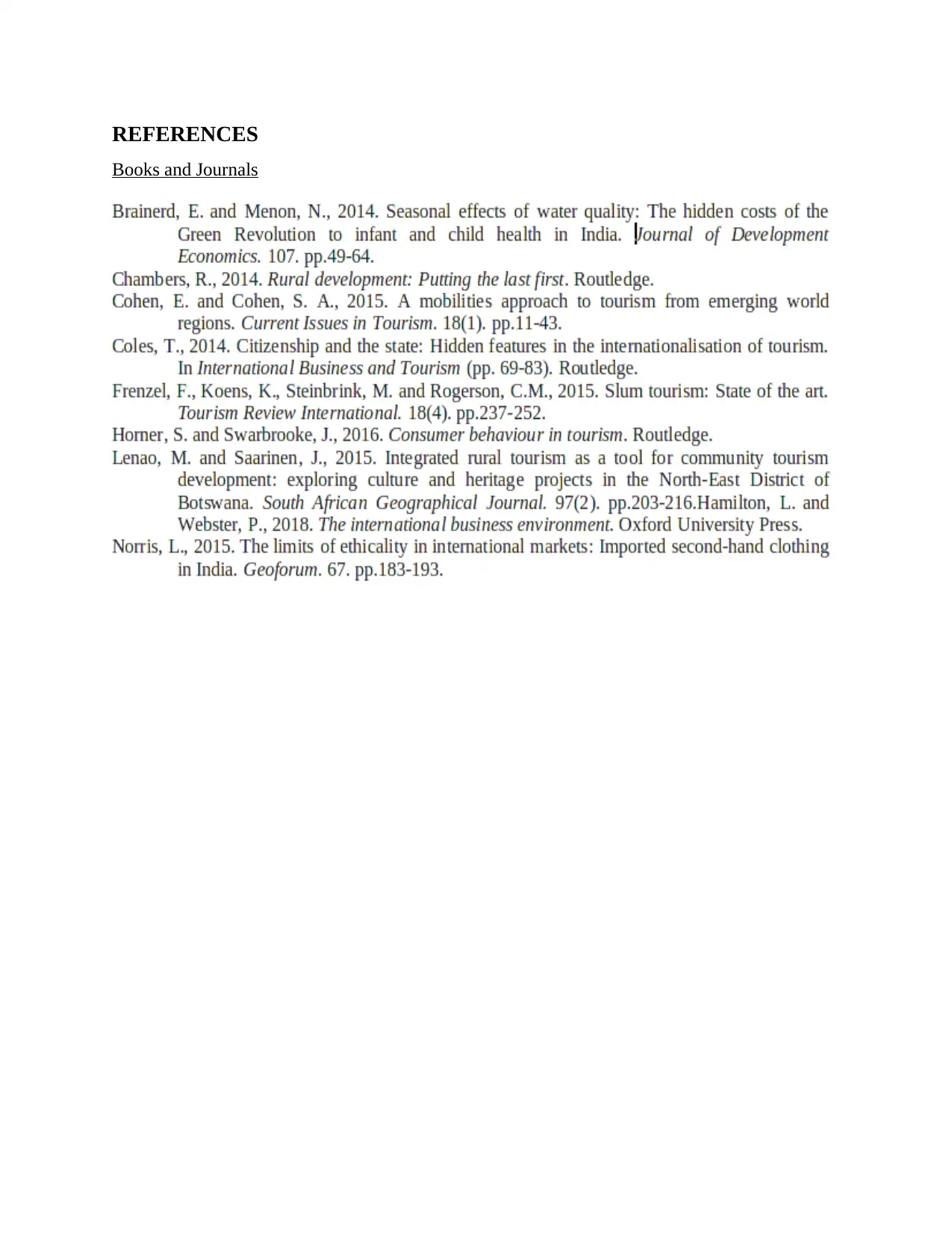
REFERENCES
Books and Journals
Books and Journals
1 out of 11
Related Documents
Your All-in-One AI-Powered Toolkit for Academic Success.
+13062052269
info@desklib.com
Available 24*7 on WhatsApp / Email
![[object Object]](/_next/static/media/star-bottom.7253800d.svg)
Unlock your academic potential
© 2024 | Zucol Services PVT LTD | All rights reserved.





